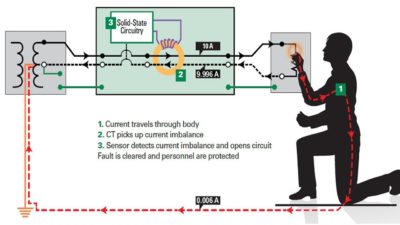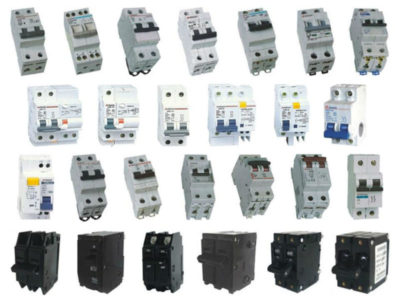Circuit Breakers and its types are safety devices that are design to protect electrical circuits from damage due to excessive current. They are install in electrical panels and automatically disconnect the circuit in the event of an overcurrent. Such as a short circuit or electrical overload. This helps to prevent damage to electrical equipment, reduce the risk of electrical fires and protect people from electrical shock. Circuit breakers come in a range of sizes and capacities, depending on the electrical load of the circuit they are protecting. They are an essential component of any electrical system, providing a crucial safety mechanism. That helps to ensure safe and reliable operation.
What Does a Circuit Breakers and its Types Do?
Let’s use a house as illustration. A house has a main electrical circuit, which use for several minor circuits. This circuit within your housing power by electricity that comes from the power factory. Under normal conditions, the electric current is regulate within safe limits or voltage limit(electric pressure), which in the US is 120 volts ± 6. This is necessary since an excess in the electric charge could damage the different factors of the structure.
But occasionally and for colorful reasons, the electrical charge can increase to situations lesser than what a circuit can tolerate, which can beget damage to the circuit and the bias connected to it, as well as starting a fire. The abecedarian function of circuit combers is to constantly “ corroborate ” that the electrical charge doesn’t exceed the safety limits and, if so, stop the operation of the electrical circuit automatically, in order to avoid damage to the electrical installation in general.
Working Principle of Circuit Breakers and its Types:
The working principle of circuit breakers is base on the magnetic and thermal properties of electric current. Circuit breakers are design to protect electrical circuits from damage due to overcurrent or short circuits by interrupting the flow of electricity. When an overcurrent is detect, the magnetic field generate by the current activates a trip mechanism. Which causes the circuit breaker to open and interrupt the flow of electricity. Similarly, when a circuit overheats due to an overload, the thermal element of the circuit breaker is activate. Causing it to trip and disconnect the circuit. Circuit breakers are a critical safety feature in electrical systems, protecting electrical equipment and preventing electrical fires and injuries.
More about Circuit Breakers and its Types:
DC Circuit Breakers:
DC Circuit Breakers are types of circuit breakers that are design to protect DC electrical systems from overloads and short circuits. They operate using a similar principle to AC circuit breakers. But are design to interrupt direct currents rather than alternating currents. DC circuit breakers are commonly use in applications such as solar power systems, battery banks and electric vehicles, where DC power is use. They are available in different current ratings and trip characteristics and can be manually or automatically reset after a trip. DC circuit breakers are essential safety devices in DC electrical systems and can prevent damage to equipment or serious injuries caused by electrical faults.
AC Circuit Breakers
AC Circuit Breakers are types of circuit breakers that are design to protect AC electrical systems from overloads and short circuits. They operate by automatically switching off the circuit when it detects a fault. Which can prevent damage to the electrical system or equipment and minimize the risk of electrical fires. AC circuit breakers are commonly use in residential, commercial and industrial applications. In addition, these are available in different current ratings and trip characteristics. They can be manually or automatically reset after a trip and are an essential safety device in AC electrical systems.
Air Circuit Breakers (ACBs)
Air Circuit Breakers (ACBs) are types of circuit breakers that use compress air to extinguish the arc that is create when the circuit is interrupt. They are commonly use in low voltage applications and are available in both fix and draw out designs. ACBs have several advantages, including high breaking capacity, low maintenance, and the ability to handle high current ratings. They are also design to provide short circuit and overload protection and have a reliable mechanism for tripping the circuit when a fault occurs. Overall, ACBs are a reliable and cost-effective option for protecting electrical systems against overloads and short circuits.
Miniature Circuit Breakers (MCBs)
Miniature Circuit Breakers (MCBs) are types of circuit breakers that are commonly use in residential and commercial applications. To protect circuits with lower current loads. They operate using a thermal or magnetic mechanism and are available in different current ratings and trip characteristics. MCBs are design to provide short circuit and overload protection and can be easily reset after a trip. They also have a compact design and are cost-effective. Making them a popular option for protecting electrical systems against overloads and short circuits. Overall, MCBs are reliable and essential components of electrical systems in buildings and facilities.
Molded Case Circuit Breakers (MCCBs)
Molded Case Circuit Breakers (MCCBs) are types of circuit breakers that are commonly use in medium voltage applications. They have a fix trip setting that cannot be adjust and operate using a thermal or magnetic mechanism. MCCBs are design to provide short circuit and overload protection and can interrupt high currents. They are available in different current ratings and interrupting capacities and can be easily reset after a trip. MCCBs also have a compact design and are cost-effective, making them a popular option for protecting electrical systems against overloads and short circuits. Overall, MCCBs are essential components of medium voltage electrical systems in buildings and facilities.
Residual Current Circuit Breakers (RCCBs)
Residual Current Circuit Breakers (RCCBs) are types of circuit breakers that are designed to protect people from electric shock. They work by detecting any difference in the current flowing in the live and neutral wires of a circuit, and interrupting the circuit if the difference exceeds a certain threshold. RCCBs are commonly use in residential and commercial applications. To protect against electric shock caused by faults in electrical appliances or wiring. They are available in different current ratings and trip sensitivities and can be install in both single-phase and three-phase electrical systems. RCCBs are essential safety devices in electrical systems and can prevent serious injuries or fatalities caused by electric shock.
Ground Fault Circuit Interrupters (GFCIs)
Ground Fault Circuit Interrupters (GFCIs) are types of electrical safety devices that are designed to protect people from electric shock. They work by detecting any difference in the current flowing in the live and neutral wires of a circuit, and interrupting the circuit if the difference exceeds a certain threshold. Moreover, GFCIs are commonly used in residential and commercial applications to protect against electric shock caused by faults in electrical appliances or wiring. They are installed in outlets or as part of the electrical panel and are available in different trip sensitivities. GFCIs are essential safety devices in electrical systems and can prevent serious injuries or fatalities caused by electric shock.
Vacuum Circuit Breakers
Vacuum Circuit Breakers are types of circuit breakers that use vacuum as the arc quenching medium instead of oil, air or gas. They are commonly use in high voltage applications and are prefer for their high interrupting capacity, long service life and low maintenance requirements. Vacuum circuit breakers operate using a vacuum interrupter that contains two contacts. Which are separate by a vacuum. When the circuit is interrupted, the vacuum interrupter extinguishes the arc that is created. Which allows for reliable interruption of high currents. Overall, vacuum circuit breakers are a reliable and cost-effective option for protecting electrical systems against overloads.
Electrical Safety Tips for Circuit Breakers and its Types:
Here are some electrical safety tips for circuit breakers:
- Know your electrical system: Understand the location and purpose of all circuit breakers in your home or workplace.
- Label your circuit breakers: Properly label each circuit breaker so you can easily identify which circuit it controls.
- Do not overload circuits: Do not plug too many devices into a single circuit. As this can cause the circuit to trip or overload.
- Use the correct size circuit breaker: Use the appropriate size circuit breaker for the electrical load to avoid overloading and overheating.
- Regularly inspect circuit breakers: Inspect circuit breakers regularly for signs of wear or damage, such as frayed wires or loose connections.
- Keep circuit breakers dry: Keep circuit breakers and the surrounding area dry and free of moisture to avoid short circuits.
- Hire a licensed electrician: If you are not comfortable working with electricity or unsure about a circuit breaker issue, hire a licensed electrician for repairs or maintenance.



